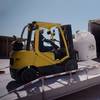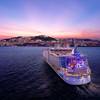Bear Grylls’ and his team cross the Northern Atlantic in a Cat engine powered RIB
The first ever unassisted crossing of the North Atlantic just south of the arctic circle in a small, open, single Caterpillar® engine powered, rib-type (Rigid Inflatable) power boat, has been completed successfully by a team of dedicated adventurers led by Bear Grylls.
Travelling from Nova Scotia to John O’Groats via a route which passed just south of the Arctic Circle, the expedition, which has raised around £50,000 for the UK young persons’ charity, The Prince’s Trust, has been completed a week ahead of schedule despite encountering icebergs and horrendous weather conditions.
The expedition, which involved a five-man team of adventurers sailing the open boat across 3000 miles of the North Atlantic on a route that saw landfall in Halifax, Nova Scotia, Mary’s Harbour in Labrador, Nanortalik, Greenland, Reykjavik, Iceland, the Faroe Islands and finally Scotland, took a total of 19 days to complete. As leader Bear Grylls explains, it was a long 19 days:
“There were undoubtedly more moments of jeopardy out there in those remote icy cold seas than I had ever anticipated, and in truth, if I had any idea of how frightened all of us would be at stages, I would have thought twice before I left everything – family and safety – for those northern waters. The boat was fantastic and the Caterpillar engine didn’t miss a single beat, despite the ever-changing sea conditions with waves at times 30 ft high.
“The support we have had from Finning (UK) Ltd and Caterpillar has been tremendous. They have not only supplied us with a first class engine but endless and unwavering technical and moral support as well as the friendship that has been the watchword of this entire expedition.”
The boat achieved a top speed of 35 knots at reduced fuel and water levels and in calm sea conditions. However, on the longest leg of the voyage - from Greenland to Reykjavik - spanning a distance of over 850 nautical miles, when loaded with additional fuel and water tanks, the average speed was 12 knots in sea conditions that included running into a force 8 gale.
“We believed that the crossing was tight but possible and we have now proved it,” comments Bear Grylls. “Choosing Cat was a big factor in making this dream a reality for us. We simply had to fit the best. The success of this venture relied very heavily on the reliability of the Cat engine and its set-up to ensure that we could cover the longest stretch of the voyage without running out of fuel in the remote North Atlantic.
“In effect we were entrusting our lives to the reliability of the Cat engine and it certainly repaid that trust.”
“There are no cabins or bunks as such – these vessels are usually used as fast, extremely manoeuvrable people movers and the boat would usually take around 12 passengers. On the challenge boat, the passenger space was taken up with stores of fuel, water, food, navigation and medical equipment. The only covered area on board was for this equipment and the team slept on top of the engine in what can only be described as a large open sardine tin!”
Commenting on behalf of UK Caterpillar dealer Finning (UK) Limited, Marine Sales Manager Eddie Smith said:
“This is fantastic news! We want to congratulate Bear Grylls and his brave team of adventurers on this wonderful achievement. We are proud to have been sponsors of this major endeavour and delighted to have had this opportunity to demonstrate the reliability and performance of the Cat 3126B marine engine.
Subscribe for
Maritime Reporter E-News
Maritime Reporter E-News is the maritime industry's largest circulation and most authoritative ENews Service, delivered to your Email five times per week










